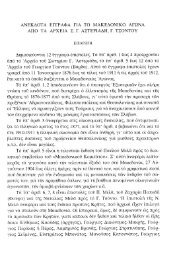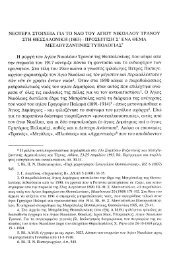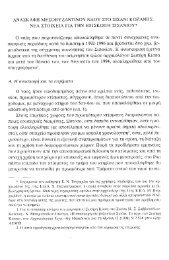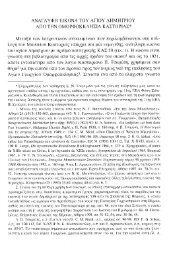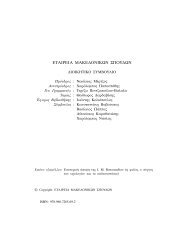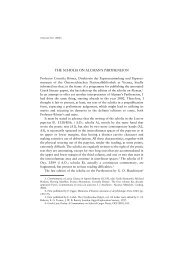GREEK EDUCATION IN MONASTIR - PELAGONIA
GREEK EDUCATION IN MONASTIR - PELAGONIA
GREEK EDUCATION IN MONASTIR - PELAGONIA
Create successful ePaper yourself
Turn your PDF publications into a flip-book with our unique Google optimized e-Paper software.
<strong>GREEK</strong> <strong>EDUCATION</strong> <strong>IN</strong> <strong>MONASTIR</strong> - <strong>PELAGONIA</strong> 21<br />
Bulgarian education, despite all the efforts of the Exarchate and the Pan-<br />
Slavist movement, was limited to the larger towns (e.g. Thessaloniki, Serres<br />
and Monastir) where a handful of boarding schools educated children from<br />
all over Macedonia, whose expenses moreover were subsidised. It is thus<br />
clear that “the number and excellence of the Greek schools in Macedonia is<br />
the best and most eloquent argument for its supremely Greek nature, as is<br />
admitted by all who visit this contested land in good faith and who study its<br />
affairs with scientific care and attention. Whatever is noble in Macedonia,<br />
whatever is splendid, whatever is flourishing, whatever is worthwhile, those<br />
things are Greek”. 9<br />
2. According to the “Statistics for Greek schools in the vilayets of<br />
Thessaloniki and Bitolia in Macedonia in the school year 1894-1895”<br />
(Thessaloniki 1896), there were in that final decade of the 19 th century 526<br />
Greek schools with 728 teachers and 30,177 pupils in the vilayet of Thessaloniki<br />
and 384 Greek schools with 517 teachers and 23,456 pupils in the<br />
vilayet of Monastir. 10<br />
Again, based on maps drawn up by the Instituto Geografico di<br />
Agostini-Roma in 1906, the observations of the representatives of the Western<br />
Powers overseeing the implementation of the Reforms and the table of<br />
statistics on the schools of Macedonia (vilayets of Thessaloniki and<br />
Monastir) that was published in that year in Paris, there were at that time<br />
521 Greek schools with 32,534 pupils and 787 teachers, 319 Bulgarian<br />
schools with 9544 pupils and 493 teachers, 10 Romanian schools with 383<br />
pupils and 28 teachers and 21 Serbian schools with 532 pupils and 52 teachers<br />
in the vilayet of Thessaloniki, and 477 Greek schools with 27,106 pupils<br />
and 676 teachers, 242 Bulgarian schools with 8767 pupils and 380 teachers,<br />
39 Romanian schools with 1619 pupils and 117 teachers and 32 Serbian<br />
schools with 1142 pupils and 60 teachers in the vilayet of Monastir, for a<br />
combined total of, respectively, schools, pupils and teachers: 988 Greek<br />
(59,640 and 1463), 561 Bulgarian (18,311 and 879), 49 Romanian (2002<br />
and 145) and 53 Serbian (1674 and 112). 11<br />
9. Ioannis . Kalostypis, Macedonia, 61; Antonis M. Koltsidas, Ideological constitution,<br />
301-302.<br />
10. Nicolaidès Cléanthès, La Macédoine. La Question macédonienne dans l’antiquité,<br />
au moyen âge et dans la politique actuelle, Berlin 1899, 138-139, with detailed statistics.<br />
11. .. -. J.C. Mazarakis-Aenian, . The<br />
Macedonian Question. La Question Macédonienne, Athens 1992, 9, 18 and back inside<br />
cover, with maps of the vilayets of Thessaloniki and Monastir; Idem,



